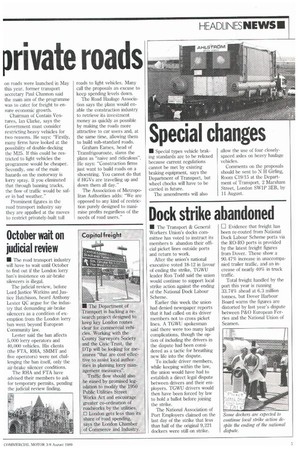Dock strike abandoned
Page 7

If you've noticed an error in this article please click here to report it so we can fix it.
• The Transport & General Workers Union's docks committee has voted to instruct its members ti abandon their official picket lines outside ports and return to work.
After the union's national executive voted 18-12 in favour of ending the strike, TGWU leader Ron Todd said the union would continue to support local strike action against the ending of the National Dock Labour Scheme.
Earlier this week the union had denied newspaper reports that it had called on its driver members not to cross picket lines. A TGWU spokesman said there were too many legal complications, though the option of including the drivers in the dispute had been considered as a tactic for breathing new life into the dispute.
To include driver members, while keeping within the law, the union would have had to establish a direct legal dispute between drivers and their employers. TGWU drivers would then have been forced by law to hold a ballot before joining the strike.
The National Association of Port Employers claimed on the last day of the strike that less than half of the original 9,221 dockers were still on strike. Evidence that freight has been re-routed from National Dock Labour Scheme ports via the RO-RO ports is provided by the latest freight figures from Dover. These show a 90.47% increase in unaccompanied trailer traffic, and an increase of nearly 40% in truck traffic.
Total freight handled by the port this year is running 33.74% ahead at 6.3 million tonnes, but Dover Harbour Board warns the figures are distorted by last year's dispute between P&O European Ferries and the National Union of Seamen.




































































































